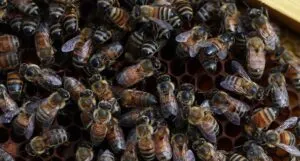What are the Dying Honey Bees Telling Us?

“It was the bumble bee and the butterfly who survived, not the dinosaur.” – Meridel Le Sueur
As a former beekeeper I am always interested in news about bees. So, when I read the headline below, I just had to read the whole article because I see what happens to the honey bees, which are a domesticated species we have put to work for us, as a clear sign about how are way of living is doing.
Scientists identify culprit behind biggest ever U.S. honey bee die-off
USDA research points to viruses spread by pesticide-resistant mites
Let’s me state once again- honey bees work for us and help us produce food by their pollination services and only secondly by providing us with delicious honey. Thus beekeepers are farmers and what happens to honey bees is telling us a little bit about our agricultural methods and how sustainable they are. Quite simple what happens to the honey bees is a sign of the stability of our entire food supply. Here is more from the article:
U.S. beekeepers had a disastrous winter. Between June 2024 and January, a full 62% of commercial honey bee colonies in the United States died, according to an extensive survey. It was the largest die-off on record, coming on the heels of a 55% die-off the previous winter. Miticide-resistant varroa mites have been a growing issue for beekeepers for years, so much so that breeders have sought to develop mite-resistant bee varieties. Since the 1980s, the parasites have evolved global resistance to at least four major classes of miticide.Mite-borne viruses probably dealt many colonies a killing blow, but other factors such as pesticide exposure or inadequate nutrition “probably” [my edit] made bees more susceptible to disease.
Once again the red flags are clear: relying upon chemicals to solve our insect or fungus problems is a short term solution. The secondary message is that mass production agriculture, which requires many expensive inputs to work: pesticides, herbicides, fertilizers, expensive machinery, is not sustainable unless it can work WITH nature and WITH insects to allow smarter and more natural control of diseases and insects. A third message is globalization: the mite killing honey bees only became a problem in the late 1800s when honey bees released by the Russians near Vladivostok – brought by the new trans-Siberian railroad – mixed with local bees that had a symbiotic relationship with the varroa mite and transferred the mite to the honey bees which had no way to fight them off. Now that mite weakened the bees but not usually kill them. That needed chemicals like Neonicotinoids which were developed in the 1980s – they and other chemicals were often the death blow. And now there is the added wrinkle is the new virus carried by the mite:
Of course bad politics has made this situation worse as resources to deal with the problem have decreased in the USA:
As soon as scientists at the U.S. Department of Agriculture (USDA) caught wind of the record-breaking die-offs, they sprang into action—but their efforts were slowed by a series of federal funding cuts and layoffs by President Donald Trump’s administration. Now, 6 months later, USDA scientists have finally identified a culprit.
So there you have it – a perfect storm of forces that have been building for decades that threaten our food supply – the basis for our lives. This is only one example of similar developments showing us that BAU – business as usual – is over. This is yet another warning from GAIA that we must change – or risk death. Are we heeding the warnings? Are we making the BIG changes needed? Are we moving toward organic, permaculture type of farming? The answer to all the above in NO. Thus, we need to prepare for the consequences AND work in some way to change our lives. Using this case that means you need to use NO pesticides/herbicides in your garden. It means you should, if able, grow some of our own food – a “Victory Garden” to use the WWII example. It means you should support local food and local honey producers as much as possible. It means that living the good life means you are doing whatever you can to be part of nature rather than using it as a resource to satisfy your desires. It also means you should be ready for major disruptions in our food supply with much higher food prices as a minimum price to pay for a food system that cannot possibly last much longer without big, big changes. If we don’t change we risk going the way of the dinosaurs.
“Should I refuse the honey because the bee stings?” – Marty Rubin
p.s.
If you want to learn more about mites and viruse as they relate to honey bee health read reference 2.
References
2. https://bee-health.extension.org/honey-bee-viruses-the-deadly-varroa-mite-associates/
Leave a Reply